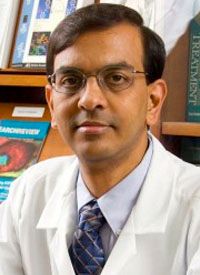CAR T Cells Push Forward in Solid Tumors Following Positive Results in Hematology
In an interview with Targeted Oncology, Prasad S. Adusumilli, MD, FACS, discussed the expansion of chimeric antigen receptor T-cell research in the solid tumor space and the challenges researchers will need to overcome in order to make this therapy effective for patients outside of the hematologic treatment landscape.
Prasad S. Adusumilli, MD, FACSSarada Krishnamurthy, MD

Prasad S. Adusumilli, MD, FACS
Chimeric antigen receptor (CAR) T-cell therapy continues to evolve through research for the treatment of patients with hematologic malignancies. In particular, cellular therapy has appeared most promising for the treatment of lymphomas and leukemias, in which the FDA has already approved several indications for CAR T cells.
As researchers continue to be impressed with responses observed with cellular therapy, there is a greater interest in moving CAR T-cell therapy into the treatment landscape for patients with solid tumors. However, there are a number of challenges with using CAR T cells in this patient population, such as the different tumor microenvironments of the disease.
The tumor microenvironment of solid tumors is also immunosuppressive, which leads to another hurdle researchers must overcome in this space. Some trials are now evaluating the combination of cellular therapy with immunotherapy.
In an interview withTargeted Oncology,Prasad S. Adusumilli, MD, FACS, deputy chief, Thoracic Surgery, Memorial Sloan Kettering Cancer Center, discussed the expansion of CAR T-cell research in the solid tumor space and the challenges researchers will need to overcome in order to make this therapy effective for patients outside of the hematologic treatment landscape.
TARGETED ONCOLOGY: What is the rationale for evaluating CAR T cells in solid tumors?
Adusumilli:Targeting CD19 is how CAR T-cell therapy has made its progress in patients with therapy-resistant cancers, mostly in leukemias and lymphomas. The complete responses are durable. I think the next step is going to be translating CAR T-cell therapy to solid tumors.
TARGETED ONCOLOGY: Where does CAR T-cell therapy fit into the landscape now for solid tumors?
Adusumilli:We are in the stage of translating preclinical to the early clinical trials. Unlike hematologic malignancies, there are several hurdles in solid tumors that are specific to the solid tumor immune microenvironment. That is where the cellular research investigators are focusing to cross each hurdle and determine how to translate this into solid tumors.
TARGETED ONCOLOGY: What are the challenges with CAR T cells in solid tumors?
Adusumilli:The challenges of solid tumors are that they notoriously do not let the CAR T cells into the tumor. Especially when the CAR T cells or other cellular therapies are given intravenously, these T cells get sequestered in the lung and slowly get to the tumor. That leads to very few T cells entering the tumor. One thing we have done to overcome that is to regionally administer intrapleural targeted CAR T cells. We first noticed we can avoid the sequestration of the T cells. Second, [we learned] androgen activation lets the CD4s help the CD8; the helper function comes in early so that CD8 CAR T cells can expand.
The other notorious factors are that there is a presence of stroma in the solid tumor cells that sequester the CAR T cells from entering the tumor mass. Solid tumor immune microenvironment is very immunosuppressive. What is well-known and well-studied is the PD-1/PD-L1 pathway where the checkpoint blockades work. However, even the CAR T cells can get exhausted in the presence of remaining antigen presence. In addition, M2 macrophages and TGF- beta, this is a solid tumor microenvironment.
More importantly, when treating patients with metastatic cancers, these are the patients we focus on in phase I clinical trials. Each organ metastasis has a different immune microenvironment, making it even more challenging to target the cells. One other reason is that CAR T cells require antigen presence to be able to target specifically. However, in solid tumors, there is not a single antigen that is expressed in all cancer cells uniformly and strongly. Even if it is expressed, it is heterogeneous.
TARGETED ONCOLOGY: What else can we do to overcome these challenges?
Adusumilli:There are several factors and advances in CAR T-cell therapy. There are many developments in the engineering of the CAR T cells themselves by modifying the hinge, modifying the co-stimulatory domains, and making them armored to overcome the immunosuppression of solid tumors. Second, we are looking at regional delivery, which appears to be working well. The third is combination immunotherapy. For example in our trials, following a single dose of intrapleural dose of CAR T cells, we give anti-PD-1 checkpoint blockade to enhance the functional assistance of CAR T cells. This also boosts antigen immune responses.
TARGETED ONCOLOGY: What are the key takeaways from this research now?
Adusumilli:It is in the early developmental phase but understanding the tumor immune microenvironment in solid tumors is how to modulate the CAR, engineering, delivery, as well as promoting their function. We already did phase I and phase II clinical trials, and hopefully, we will see some results in the near future.
TARGETED ONCOLOGY: Do you see CAR T cells having a role in this space?
Adusumilli:I think so. It is not just CAR T cells, but what we are learning from the checkpoint blockade immunotherapy, the immune microenvironment and the tumors, and the immune resistance mechanism. With a combination of these, I am optimistic that in the next 5 years we will see CAR T-cell therapy potentially playing an important role in solid tumor treatment.
The main message is choosing the correct antigen and designing a CAR specific to the solid tumor, and delivery of focus for each of the solid tumors can be different. Most importantly, doing correlative science to be able to understand the changes happening in the tumor microenvironment [is important] so that we can develop next-generation CAR T cells.









